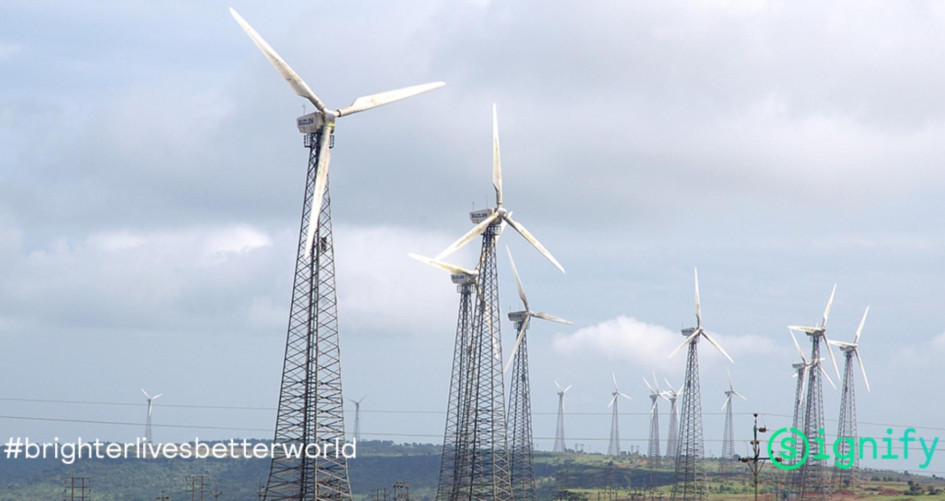Signify achieved its goal of becoming carbon neutral in all of its operations across the world, as well as using 100% renewable electricity in September 2020. It continues to increase the energy efficiency of its products, systems and services to drive the transition to a low-carbon economy.
To ensure its efforts are in line with the latest climate science and the Paris Agreement, Signify has set science-based targets in line with the 1.5°C pathway. The company has been recognized as an ‘Industry Leader’ in the Dow Jones Sustainability Index for three consecutive years and holds a place on CDP’s Climate A List.
Key facts
- Over the last decade, Signify has reduced its carbon footprint by more than 70% and has transformed all of its global markets to carbon neutrality
- Signify shifted to 100% renewable electricity through two virtual power purchase agreements, one in Texas and one in Poland
- To ensure the company is in line with the targets set out in the Paris Agreement, Signify has committed to reduce 70% of scope 1 and 2 emissions, and 30% of scope 3 emissions by 2030
- Over the last 5 years Signify reduced its carbon footprint to achieve the following reductions
46% in factories – more energy efficient technologies
92% in offices – more efficient space utilization, switch to LED lighting
52% in logistics – reducing air freight, more sea freight
80% in business travel – reduced and more sustainable travel, shifting to an electric car fleet
- As a result, Signify announced achieving 100% carbon neutrality and 100% renewable electricity in September 2020
The challenge
The world is increasingly feeling the pressure of demographic change, urbanization, resource scarcity and climate change. At the same time Signify’s stakeholders need solutions to meet increasing challenges related to food availability, safety & security and health & wellbeing. As a purpose-driven organization, Signify understands the importance of taking urgent action and this is why it has aligned its business strategy with the UN Sustainable Development Goals (UN SDGs).
The solution
On December 7, 2015, Signify’s CEO Eric Rondolat addressed the COP21 Energy Day Summit urging leaders to set more aggressive targets to fight climate change, and announced that Signify would play its part by committing to become a carbon neutral company by the end of 2020.
The company’s achievements were only possible through the support of strong leadership and the engagement of every employee. At Signify, targets are set at a corporate level, as well as in business divisions and markets, to achieve its bold commitments. By showing leadership on the journey to carbon neutrality, Signify’s employees have become ambassadors for sustainability.
The remaining carbon footprint of Signify’s business is reduced through carbon offsetting projects aimed at benefitting the wellbeing of local communities.
Signify is partnering with South Pole, a global market leader in sustainability solutions, products and services that helps companies reach their most ambitious climate and sustainability commitments.
Thanks to this partnership, the company has gained access to over a decade’s worth of experience in creating global impact through green power, carbon credits, and developing certified emission reduction projects.
Signify was proud to initiate a tailor-made offsetting project to support off-grid renewable energy generation with solar panels in India. By sponsoring this project, Signify improved light availability and thereby wellbeing in the local community.
Spillover effect
Best practice sharing and peer learning are common practices among Signify’s factories. Peer learning communities ensure that energy reducing practices are replicated throughout its manufacturing activities.
Additionally, to ensure its carbon neutrality commitment is followed and replicable at every level of the company, Signify tracks a virtual carbon fee on air freight emissions to reduce them. The company’s divisions and markets have a quarterly air freight emissions target and their performance is evaluated. Excess emissions are translated into a virtual penalty on their operating budget to show what impact they would have if they would be charged.
Another replicable example is the company’s program to optimize the lease fleet, identifying opportunities to shift to electrical vehicles, especially in the Benelux.
Signify continues to partner with the Climate Group’s EV100 Initiative to operate a lease fleet of hybrid and fully electric vehicles (EVs) by 2030. Such ideas can be applicable to other industries and contribute to a low-carbon economy.
Taking the next step
Signify’s journey has not come to an end by achieving carbon neutrality. Signify will go beyond and aims to double its positive impact on the environment and society by doubling the pace of the Paris Agreement to reach the 1.5 °C goal in 2025 – six years early. Read more about the company’s Brighter Lives, Better World 2025 commitments on its webpage.




Images owned by the activity partners, all rights reserved.





